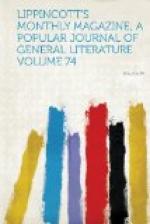[Illustration: “THE EXAMINADOR AND THE COLONEL HOPPED VALIANTLY OVER THE MENDOZA.”]
The above style of threatening the saints is thought very efficacious in all Spanish countries. Whether or not Saint Lawrence really dreaded another experience of broiling, at the end of certain hours the Bolivians reappeared, and their chief deposited in the hands of the colonel a few green and tender branches. At the joyful shout of Perez, the man of letters, who had been occupied in making a sketch, came running up. Two different species of cinchona were the trophy brought back by Lorenzo, like the olive-leaves in the beak of Noah’s dove. One of these specimens was a variety of the Carua-carua, with large leaves heavily veined: the other was an individual resembling those quinquinas which the botanists Ruiz and Pavon have discriminated from the cinchonas, to make a separate family called the Quinquina cosmibuena. After all, the discovery was rather an indication than a conquest of value. The examinador admitted as much, but observed that the presence of these baser species always argued the neighborhood of genuine quinine-yielding plants near by.
In the presence of this first success on the part of the exploration set on foot by Don Juan Sanz de Santo Domingo, we may insert a few words on the nature of the wonderful plant toward which its researches were directed.
It is doubtful whether the aboriginal inhabitants of Peru, Bolivia and Ecuador were acquainted with the virtues of the cinchona plant as a febrifuge. It seems probable, nevertheless, that the Indians of Loxa, two hundred and thirty miles south of Peru, were aware of the qualities of the bark, for there its use was first made known to Europeans. It was forty years after the pacification of Peru however, before any communication of the remedial secret was made to the Spaniards. Joseph de Jussieu reports that in 1600 a Jesuit, who had a fever at Malacotas, was cured by Peruvian bark. In 1638 the countess Ana of Chinchon was suffering from tertian fever and ague at Lima, whither she had accompanied the viceroy, her husband. The corregidor of Loxa, Don Juan Lopez de Canizares, sent a parcel of powdered quinquina bark to her physician, Juan de Vega, assuring him that it was a sovereign and infallible remedy for “tertiana.” It was administered to the countess, who was sixty-two years of age, and effected a complete cure. This countess, returning with her husband to Spain in 1640, brought with her a quantity of the healing bark. Hence it was sometimes called “countess’s bark” and “countess’s powder.” Her famous cure induced Linnaeus, long after, to name the whole genus of quinine-bearing trees, in her honor, Cinchona. By modern writers the first h has usually been dropped, and the word is now almost invariably spelled in that way, instead of the more etymological Chinchona. The Jesuits afterward made great and effective use




